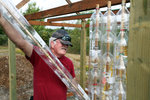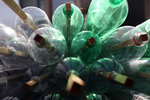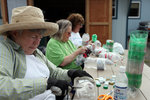


A plastic pop bottle seems to last forever when it’s lying by the side of the road where it was tossed out by a careless passing driver.
Now, instead of being a burden, plastic pop bottles are finding a new life as places to grow plants: the smaller ones as cold frames and the bigger ones as greenhouses. Lewis County Master Composters are the driving force behind the pop bottle greenhouse project currently under construction at the Lewis County Transfer Station in Centralia.
“We teach people how to compost and about worm composting — but we also want to teach them how to reuse materials that end up in the landfill,” said Debbie Burris, master recycler composter coordinator at Lewis County.
“Most of the time when we talk about reusing, people think we are talking about making cutesy little ornaments to put on a Christmas tree and people are turned off by that,” she said. “We want to be able to show the ways you can recycle and make things that are truly useful.”
Burris was hunting around for a way to make cold frames out of the smaller pop bottles when she hit upon an ambitious 2-liter pop bottle project fashioned by young students in Scotland.
She was instantly hooked.
“Lewis County has lots of gardeners who would like a greenhouse but can’t afford one,” she said. Recycling and saving pop bottles from the landfill and making gardeners happy was the best of both worlds with this project.
The 8-foot by 12-foot greenhouse will require 1,500 pop bottles.
After sending out requests throughout the county, enough pop bottles were collected to begin the project (more are still needed to finish it). Burris and the Master Recyclers spent hours preparing the bottles by removing labels and cutting off the bottoms.
The Master Composters have a demonstration composting site at the Lewis County Transfer Station in Centralia. The greenhouse is now under construction at the site located behind the office.
The idea of reusing pop bottles in building construction is not new. The 2-liter plastic bottles are already used throughout the world in a variety of building projects — from artistic walls (in a restaurant in Seattle) to entire houses.
The composters were hard at work Monday assembling the first part of the greenhouse project. Cost of additional purchased materials for the project thus far runs around a $100 and includes purchased cement and posts.
“Everything else was recycled,” Burris said. “We used recycled 2x4 deck lumber, recycled roofing nails and rejected, six foot cedar fence boards ripped into five-eighths strips.”
Even the cement was poured into cleverly repurposed forms. The forms were big tubes used as a shipping container and cut to make the forms to mold the cement.
Alice Fisher is a master composter and is also an avid recycler who was on hand Monday assembling the greenhouse.
“When I started recycling, my garbage bill was cut in half,” she said. “Just by taking the newspaper out, well, that’s a really big item.”
Fisher is working on the greenhouse project.
“Its biggest use is for starting seeds,” she said, “and plants, before the weather permits, so that we have protection for the plants when they are vulnerable.”
One of the great side effects of the pop bottle construction is in the little gaps that are between each bottle. This allows humidity to escape and rain water to seep in. No additional venting or heating is required.
The project is not too difficult, and is something just about anyone can construct.
“It’s actually very lightweight,” said Burris. “It’s not difficult and doesn’t require any special carpentry skills. You can make it as elaborate or as simple as you want. We have instructions available and then, just use your imagination.”
Preparing the bottles is the most time-consuming part of the project.
“During the winter months when we can’t be outside, take a bag of the bottles, remove the caps, slice off the bottoms and stack them into each other like cups,” she said. “You can do this while watching TV and even the kids can help.”
Snow load is not an issue because of the warmth inside the structure and the high peak. And even if something does break it’s not a problem.
“If it breaks, you just go and replace it,” she said.
And as the bottles weather and perhaps become brittle, the entire structure can be recycled.
Best of all, it’s cheap and almost free to construct, unlike traditional greenhouses.
“I have a really nice greenhouse at home,” Burris said. “And between a branch that came down and replacing the polycarbonate, it would cost me more to repair the damage than to just go build or buy a new one.”
•••
How to Build a Pop Bottle Greenhouse
1 — Prepare the Pop Bottles
Gather up to 1,500 2-liter pop bottles, enough for an 8-foot by 10-foot greenhouse.
Take the labels off. Do this by soaking the bottles in soapy water.
Cut the bottoms off the bottles.
2 — Assemble the pop bottles
Take bamboo shoots or dowel-like strips of wood.
String the pop bottles together on the dowels.
Staple the dowels to the frame (instructions below) at top and bottom.
3 — Make the frame
Picture the frame as if you were outlining a box. You have four corner posts and connecting laterals to construct.
Set up your four corner posts. Treated 4x4 posts sunk into the ground are very sturdy.
Create the frame out of 2x2 timber with mitered corners screwed together.
4 — Make the Roof
The roof can be recycled corrugated paneling, or of pop bottle construction.
Make two triangular frames (gables) and staple the doweled bottles onto the roofing gables, and the gables onto the posts.
Attach a long top beam and vertical supports.
Fashion the roof out of pop bottles on dowels and assemble.
•••
About the Master Composter Demonstration Site
The Master Composter composting demonstration site is located at the Lewis County Transfer Station.
After visitors reach the scales, turn right and approach the demonstration site, located behind the administration building.
The site is set up with a path through a row. One one side are commercial compost bins and on the other side are compost bins made by the Master Gardeners and available for sale. Two choices are available for sale at a large discount on site, including a $5, open, round eco bin and a Seattle based company made compost bin for $30.
At the end of the row is the new greenhouse.
The transfer station is open from 7:30 a.m. to 5:30 p.m. Monday through Saturday.
Composting and greenhouse instruction brochures are available there.
The Master Composters will utilize the site to make compost and to grow plants for the annual plant sale at the greenhouse.
•••
More Pop Bottles needed
The Lewis County Master Composters are in need of many more pop bottles to complete the demonstration pop bottle greenhouse at the Lewis County Transfer Station Master Composter Demonstration composting site.
Several donation sites are available for dropping off bottles.
Both clear and green plastic bottles are accepted.
Drop off sites are at the Lewis County Courthouse on the tables in front of the Master Gardener office. The office is located at: 351 N.W. North St. in Chehalis. Hours are Monday through Wednesday from 9 a.m. to 3 p.m.
A drop off site is also available next to the transfer office and next to the co-mingled recycling dumpsters at the transfer station.
•••
Beware Killer Compost
Lewis County Master Composters have recently encountered a new and dangerous problem when creating homegrown compost. Killer compost, as it has become known, will kill any living plant it comes into contact with. The compost is created accidentally when plants treated with herbicides are mistakenly added to a compost bin.
“Killer compost has been around but this is the first time we have encountered it that we are aware of,” said Burris. “Now that people are busy trying to produce their own food, this is something they really need to be aware of.”
Killer compost contains tiny traces of the very potent herbicide used when applied to grasses and hay fields. The potency does not break down easily and as small an amount as three parts per billion will destroy delicate pepper and tomato plants.
“We have to be very careful what goes into the compost and we are wanting to let the public know,” Burris said. Several composting education workshops are planned for September.